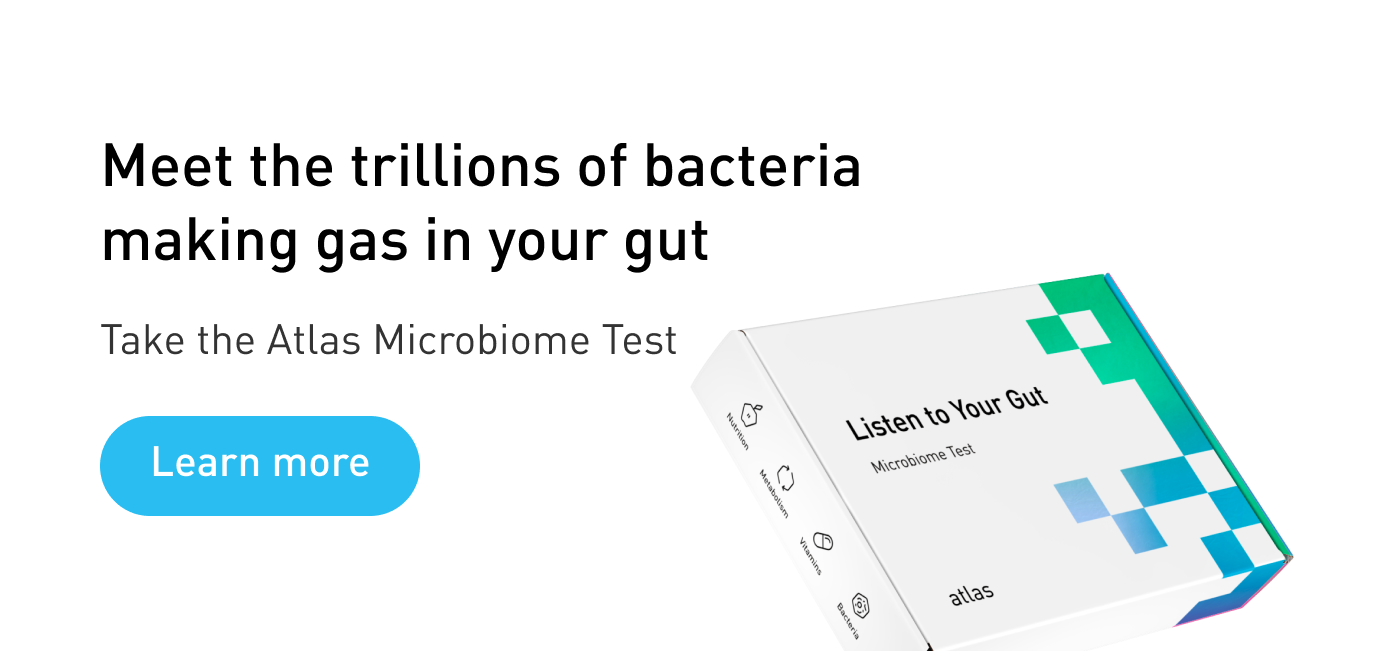Excessive wind, smelly farts, and bad flatulence could be caused by something in your diet. Find out what foods cause flatulence in this top seven gassy foods list.
Humans fart 5–15 times per day. Even though farting is perfectly normal, excessive wind can lead to embarrassing situations and lingering smells that make socialising difficult or impossible.
Fortunately, dietary changes can cure excessive flatulence because gas is often linked to specific foods, which are fermented by gut bacteria in the large intestine. Microbes release gas as they break down undigested food particles. Eventually, enough gas accumulates and is released by the anus.
Table of contents
- Beans and legumes
- Jerusalem artichoke
- Cruciferous vegetables
- Milk and dairy products
- Gluten and wheat
- High-protein diet
- Polyol sweeteners
In particular, high-fiber foods, like vegetables and legumes, nourish healthy and harmless gut bacteria, which turn them into beneficial substances like vitamins and prebiotics, with flatulence as a side effect. This is why going vegan or vegetarian can make people gassy.
Foul-smelling flatulence is caused by hydrogen sulfide, which makes farts smell like rotten eggs or cabbage. Some gut bacteria, like Desulfovibrio and Desulfobulbus, produce hydrogen sulfide from amino acids in food, like cysteine and methionine.

Digestive health problems can also cause bad wind and constant farting. Excessive flatulence can be caused by lactose intolerance (which can happen at any age), as well as irritable bowel syndrome (IBS), and untreated celiac disease.
☝️DISCLAIMER☝This article is for informational purposes only. It is not intended to constitute or be a substitute for professional medical advice, diagnosis, or treatment.
1. Beans and legumes

Beans and legumes, such as lentils, are foods that cause flatulence and bloating. They contain galactooligosaccharides (GOS) and fructans, which are dietary fibers that can’t be broken down by human enzymes. Instead, they are fermented by gut bacteria in the large intestine.
People with irritable bowel syndrome are more susceptible to digestive pain caused by gas, which is why some dietitians recommend following a low-FODMAP diet, which excludes foods that contain fructans and galactooligosaccharides, like beans and legumes.
☝️QUICK FIX Alpha-galactosidase, a digestive enzyme sold under the name of Beano, can reduce flatulence problems caused by beans and legumes.
2. Jerusalem artichoke
Jerusalem artichoke, also known as sunchoke, is a starchy edible root. It contains high levels of inulin, a very gassy non-digestible carbohydrate that is fermented by gut bacteria. It has such potent flatulence powers that professional chefs and gardeners have nicknamed it the fartichoke.
Inulin is a prebiotic that good gut bacteria turn into butyrate, a short-chain fatty acid which keeps the gut lining healthy. It also enhances the absorption of magnesium and calcium – micronutrients that support bone health, nerve and muscle function, and more.
☝️QUICK FIX Avoid or consume very small portions of Jerusalem artichoke when it’s in season.
3. Cruciferous vegetables
Cabbage, broccoli, cauliflower, and other cruciferous vegetables are common foods that cause flatulence and gas. These plants release sulfur-containing organic compounds, called glucosinolates, when the leaves are cooked and/or chewed. Common cruciferous vegetables include:
- Broccoli
- Cabbage
- Cauliflower
- Dark leafy greens (kale, collard greens, mustard greens, etc.)
- Kohlrabi
- Radish
- Rutabaga
- Turnips
Glucosinolates (and the products of their breakdown) have health-promoting effects for the human body. Studies show that a wide variety of gut bacteria transform glucosinolates into sulfate and ferrous ions, which can be further metabolised into hydrogen sulfide (which makes farts smell like rotten eggs) and sulfur respectively.
On the plus side, glucosinolates fuel probiotic bacteria that naturally reside in the human gut, like Lactobacillus and Bifidobacterium. On the other hand, a gut with too many sulfate-reducing bacteria, like Desulfovibrio, can increase hydrogen sulfide production, which causes really smelly farts.
☝Take a gut bacteria test☝ The Atlas Microbiome Test detects which bacteria live in your gut and if your sulfate-reducing bacteria are overabundant.
4. Milk and dairy products

Milk and dairy products are foods that cause foul-smelling flatulence if you have untreated lactose intolerance. Lactose is a sugar present in milk that is normally broken down by an enzyme called lactase.
Probiotic gut bacteria, like Lactobacillus, are able to metabolise and absorb lactose. This can lessen the symptoms of lactose intolerance, especially in people whose diets contain a flatulent non-digestible carbohydrate, known as galactooligosaccharide, (GOS), which is found in beans.
☝See how your bacteria influence lactose digestion☝ The Atlas Microbiome Test detects bacteria that can alleviate lactose intolerance.
5. Wheat and gluten

Non-celiac gluten sensitivity is another wheat-related condition, in which gluten triggers digestive symptoms, including excessive wind, but without causing damage to the intestines. Research shows that some gut bacteria break down gluten into particles that irritate the immune system, and this could be part of the problem.
Even though gluten-free diets are very popular, they should not be taken lightly. Gluten-free diets are very restrictive – they can lead to nutritional deficiencies and cause microbiome imbalances, which may even exacerbate flatulence. Always consult a doctor or nutritionist before making dietary changes.
6. High-protein diet

High-protein diets, like the ketogenic diet and the carnivore diet, are brimming with foods that cause foul-smelling flatulence. Beef, eggs, pork, fish, and poultry are rich in sulfur, which can be turned into hydrogen sulfide by gut bacteria, resulting in foul-smelling gas that is reminiscent of rotten eggs.
In addition, protein bars and protein shakes also contain low-calorie sweeteners (sorbitol, mannitol, lactitol, and xylitol) and fiber additives that are known to cause flatulence. In particular, many protein bars use inulin, a very gassy non-digestible carbohydrate, as a source of fiber.
7. Polyol sweeteners
Many processed foods, especially low-calorie and low-carb foods, can cause flatulence if they contain plant-derived sweeteners, called polyols. These FODMAP foods are associated with digestive symptoms, including gas and bloating:
| sorbitol | mannitol |
| lactitol | xylitol |
Polyols are sugar alcohols with sweetening properties that can’t be digested by the human body. Instead, they are metabolised by gut bacteria in the large intestine, where they can cause excessive wind. Polyols are also used in the pharmaceutical industry as laxatives.
Conclusion
There are many different foods that cause flatulence, mainly due to the composition and activities of your natural gut bacteria. Excessive wind caused by a high-fiber diet is perfectly normal.
If you also experience gas-related pain when you introduce new plant foods to your diet, try cutting back down and reintroducing gassy foods slowly. This is particularly important for hard-to-digest foods, like beans and cruciferous vegetables.
Foul-smelling farts are often caused by a diet high in cruciferous vegetables and animal protein. These foods contain organic sulfur compounds that bacteria can turn into hydrogen sulfide, a gas that smells like rotten eggs.
Sometimes excessive wind is the side effect of a health issue, like lactose intolerance, gluten intolerance, or IBS. If you experience chronic abdominal symptoms, including diarrhoea, bloating, chronic flatulence, and abdominal pain, consult your doctor.





















